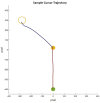Age-related changes in motor planning for prior intentions: a mouse tracking reach-to-click task
- PMID: 38562237
- PMCID: PMC10983849
- DOI: 10.3389/fpsyg.2024.1323798
Age-related changes in motor planning for prior intentions: a mouse tracking reach-to-click task
Abstract
When we complete sequential movements with different intentions, we plan our movements and adjust ahead. Such a phenomenon is called anticipatory planning for prior intentions and is known to decline with age. In daily life activities, we often need to consider and plan for multiple demands in one movement sequence. However, previous studies only considered one dimension of prior intentions, either different types of onward actions or different precisions of fit or placement. Therefore, in this study, we investigated anticipatory planning for both extrinsic (movement direction) and intrinsic (fit precision) target-related properties in a computer-based movement task and analyzed the computer cursor movement kinematics of both young and older adults. We found that older people consider and adjust for different properties step-by-step, with movement direction being considered as a prior intention during reach movement and fit precision as a motor constraint during drop movement. The age-related changes in the completion of onward actions are constrained by one's general cognitive ability, sensorimotor performance and effective motor planning for prior intentions. Age-related decline in motor planning can manifest as counterproductive movement profiles, resulting in suboptimal performance of intended actions.
Keywords: aging; computer mouse cursor tracking; kinematic analysis; motor planning; prior intention.
Copyright © 2024 Zhang, Wilmut, Zhang and Wang.
Conflict of interest statement
The authors declare that the research was conducted in the absence of any commercial or financial relationships that could be construed as a potential conflict of interest. The author(s) declared that they were an editorial board member of Frontiers, at the time of submission. This had no impact on the peer review process and the final decision.
Figures







Similar articles
-
The "why" of reaching: Second-order planning across the adult lifespan.Psychol Aging. 2019 May;34(3):431-440. doi: 10.1037/pag0000335. Epub 2019 Mar 7. Psychol Aging. 2019. PMID: 30843710
-
Infants prospectively control reaching based on the difficulty of future actions: To what extent can infants' multiple-step actions be explained by Fitts' law?Dev Psychol. 2017 Jan;53(1):4-12. doi: 10.1037/dev0000212. Dev Psychol. 2017. PMID: 28026189
-
To throw or to place: does onward intention affect how a child reaches for an object?Exp Brain Res. 2013 May;226(3):421-9. doi: 10.1007/s00221-013-3453-0. Epub 2013 Mar 2. Exp Brain Res. 2013. PMID: 23455727
-
Cortically Evoked Movement in Humans Reflects History of Prior Executions, Not Plan for Upcoming Movement.J Neurosci. 2023 Jul 5;43(27):5030-5044. doi: 10.1523/JNEUROSCI.2170-22.2023. Epub 2023 May 26. J Neurosci. 2023. PMID: 37236809 Free PMC article.
-
Guiding Movements by Constantly Reconsidering One's Actions: A Kinematic Approach.Annu Rev Vis Sci. 2025 Jun 2. doi: 10.1146/annurev-vision-110323-103554. Online ahead of print. Annu Rev Vis Sci. 2025. PMID: 40455833 Review.
References
LinkOut - more resources
Full Text Sources

